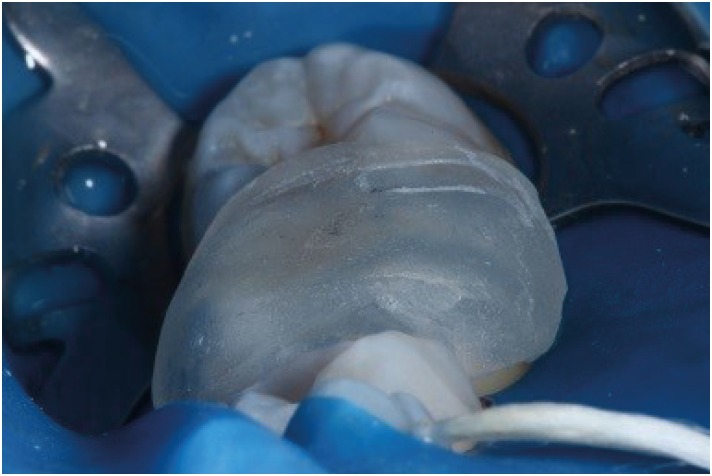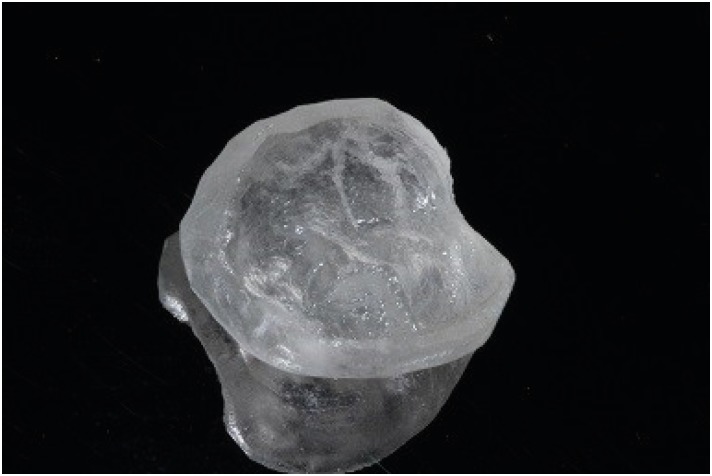Articles
- Page Path
- HOME > Restor Dent Endod > Volume 45(1); 2020 > Article
- Case Report Functional and aesthetic rehabilitation in posterior tooth with bulk-fill resin composite and occlusal matrix
-
Luciana Fávaro Francisconi-dos-Rios1
 , Johnny Alexandre Oliveira Tavares2
, Johnny Alexandre Oliveira Tavares2 , Luanderson Oliveira3
, Luanderson Oliveira3 , Jefferson Chaves Moreira3
, Jefferson Chaves Moreira3 , Flavia Pardo Salata Nahsan2
, Flavia Pardo Salata Nahsan2
-
Restor Dent Endod 2020;45(1):e9.
DOI: https://doi.org/10.5395/rde.2020.45.e9
Published online: January 3, 2020
1Department of Operative Dentistry, School of Dentistry, University of São Paulo, São Paulo, SP, Brazil.
2Program in Dentistry, Department of Dentistry, Federal University of Sergipe, Aracaju, SE, Brazil.
3Department of Dentistry, Federal University of Sergipe, Aracaju, SE, Brazil.
- Correspondence to Flavia Pardo Salata Nahsan, DDS, MSC, PhD. Adjunct Professor, Program in Dentistry, Federal University of Sergipe, Rua Claudio Batista, s/n, Aracaju, SE 49060-100, Brazil. flavia_odonto@hotmail.com
Copyright © 2020. The Korean Academy of Conservative Dentistry
This is an Open Access article distributed under the terms of the Creative Commons Attribution Non-Commercial License (https://creativecommons.org/licenses/by-nc/4.0/) which permits unrestricted non-commercial use, distribution, and reproduction in any medium, provided the original work is properly cited.
- 1,230 Views
- 19 Download
- 4 Crossref
Abstract
- The restorative procedure in posterior teeth involves clinical steps related to professional skill, especially when using the incremental technique, which may fail in the long term. A recent alternative is bulk-fill resins, which can reduce polymerization shrinkage, decreasing clinical problems such as marginal leakage, secondary caries, and fracture. This scientific study aims to report a clinical case using bulk-fill resin with an occlusal matrix. As determined in the treatment plan, an acrylic resin matrix was produced to establish an improved oral and aesthetic rehabilitation of the right mandibular first molar, which presented a carious lesion with dentin involvement. The occlusal matrix is a simple technique that maintains the original dental anatomy, showing satisfactory results regarding function and aesthetic rehabilitation.
INTRODUCTION
CASE REPORT
After phosphoric acid and adhesive layer placed, Bulk Fill composite resin as placed in the cavity with one increment.

DISCUSSION
CONCLUSION
-
Conflict of Interest: No potential conflict of interest relevant to this article was reported.
-
Author Contributions:
Conceptualization: Francisconi-dos-Rios LF, Nahsan FPS.
Data curation: Oliveira L.
Formal analysis: Francisconi-dos-Rios LF, Nahsan FPS.
Investigation: Tavares JAO, Oliveira L.
Methodology: Tavares JAO, Moreira JC.
Project administration: Tavares JAO.
Resources: Oliveira L, Nahsan FPS.
Supervision: Francisconi-dos-Rios LF, Nahsan FPS.
Writing - original draft: Francisconi-dos-Rios LF, Tavares JAO, Oliveira L, Moreira JC, Nahsan FPS.
Writing - review & editing: Francisconi-dos-Rios LF, Moreira JC, Nahsan FPS.
- 1. Richards D. Oral diseases affect some 3.9 billion people. Evid Based Dent 2013;14:35.ArticlePubMedPDF
- 2. Demarco FF, Corrêa MB, Cenci MS, Moraes RR, Opdam NJ. Longevity of posterior composite restorations: not only a matter of materials. Dent Mater 2012;28:87-101.ArticlePubMed
- 3. Laegreid T, Gjerdet NR, Johansson A, Johansson AK. Clinical decision making on extensive molar restorations. Oper Dent 2014;39:E231-E240.ArticlePubMedPDF
- 4. Yazici AR, Antonson SA, Kutuk ZB, Ergin E. Thirty-six-month clinical comparison of bulk fill and nanofill composite restorations. Oper Dent 2017;42:478-485.ArticlePubMedPDF
- 5. Costa T, Rezende M, Sakamoto A, Bittencourt B, Dalzochio P, Loguercio AD, Reis A. Influence of adhesive type and placement technique on postoperative sensitivity in posterior composite restorations. Oper Dent 2017;42:143-154.ArticlePubMedPDF
- 6. van Dijken JW, Pallesen U. A randomized controlled three year evaluation of “bulk-filled” posterior resin restorations based on stress decreasing resin technology. Dent Mater 2014;30:e245-e251.ArticlePubMed
- 7. Margeas RC. Bulk-fill materials: simplify restorations, reduce chairtime. Compend Contin Educ Dent 2015;36:e1-e4.PubMed
- 8. Zorzin J, Maier E, Harre S, Fey T, Belli R, Lohbauer U, Petschelt A, Taschner M. Bulk-fill resin composites: polymerization properties and extended light curing. Dent Mater 2015;31:293-301.ArticlePubMed
- 9. Ilie N, Bucuta S, Draenert M. Bulk-fill resin-based composites: an in vitro assessment of their mechanical performance. Oper Dent 2013;38:618-625.ArticlePubMedPDF
- 10. Alshali RZ, Silikas N, Satterthwaite JD. Degree of conversion of bulk-fill compared to conventional resin-composites at two time intervals. Dent Mater 2013;29:e213-e217.ArticlePubMed
- 11. El-Damanhoury H, Platt J. Polymerization shrinkage stress kinetics and related properties of bulk-fill resin composites. Oper Dent 2014;39:374-382.ArticlePubMedPDF
- 12. Olegário IC, Hesse D, Bönecker M, Imparato JC, Braga MM, Mendes FM, Raggio DP. Effectiveness of conventional treatment using bulk-fill composite resin versus Atraumatic Restorative Treatments in primary and permanent dentition: a pragmatic randomized clinical trial. BMC Oral Health 2016;17:34.PubMedPMC
- 13. Braz R, Mergulhão VA, Oliveira LR, Alves MS, Canto CA. Flared roots reinforced with bulk-fill flowable composite-case report. Oper Dent 2018;43:225-231.ArticlePubMedPDF
- 14. Alqudaihi FS, Cook NB, Diefenderfer KE, Bottino MC, Platt JÁ. Comparison of internal adaptation of bulk-fill and increment-fill resin composite materials. Oper Dent 2019;44:E32-E44.ArticlePubMedPDF
- 15. Ammannato R, Rondoni D, Ferraris F. Update on the ‘index technique’ in worn dentition: a no-prep restorative approach with a digital workflow. Int J Esthet Dent 2018;13:516-537.PubMed
- 16. Veloso SR, Lemos CA, de Moraes SL, do Egito Vasconcelos BC, Pellizzer EP, de Melo Monteiro GQ. Clinical performance of bulk-fill and conventional resin composite restorations in posterior teeth: a systematic review and meta-analysis. Clin Oral Investig 2019;23:221-233.ArticlePubMedPDF
- 17. Maghaireh GA, Price RB, Abdo N, Taha NA, Alzraikat H. Effect of thickness on light transmission and Vickers hardness of five bulk-fill resin-based composites using polywave and single-peak light-emitting diode curing lights. Oper Dent 2019;44:96-107.ArticlePubMedPDF
- 18. Tauböck TT, Jäger F, Attin T. Polymerization shrinkage and shrinkage force kinetics of high- and low-viscosity dimethacrylate- and ormocer-based bulk-fill resin composites. Odontology 2019;107:103-110.ArticlePubMedPDF
- 19. Kruly PC, Giannini M, Pascotto RC, Tokubo LM, Suga US, Marques AC, Terada RS. Meta-analysis of the clinical behavior of posterior direct resin restorations: low polymerization shrinkage resin in comparison to methacrylate composite resin. PLoS One 2018;13:e0191942.ArticlePubMedPMC
- 20. AlSagob EI, Bardwell DN, Ali AO, Khayat SG, Stark PC. Comparison of microleakage between bulk-fill flowable and nanofilled resin-based composites. Interv Med Appl Sci 2018;10:102-109.ArticlePubMedPMC
REFERENCES
Tables & Figures
REFERENCES
Citations

- Mastery of Aesthetic and Functional Restoration of Maxillary Molars Using the Technique of Direct Restoration (Clinical Case)
Yu. Kolenko
SUCHASNA STOMATOLOHIYA.2025; (2): 67. CrossRef - Color stability of bulk‐fill compared to conventional resin‐based composites: A scoping review
Gaetano Paolone, Mauro Mandurino, Nicola Scotti, Giuseppe Cantatore, Markus B. Blatz
Journal of Esthetic and Restorative Dentistry.2023; 35(4): 657. CrossRef - Evaluation of Abfraction Lesions Restored with Three Dental Materials: A Comparative Study
Bogdan Constantin Costăchel, Anamaria Bechir, Alexandru Burcea, Laurența Lelia Mihai, Tudor Ionescu, Olivia Andreea Marcu, Edwin Sever Bechir
Clinics and Practice.2023; 13(5): 1043. CrossRef - Aesthetic restoration of posterior teeth using different occlusal matrix techniques
Elsa Reis Carneiro, Anabela Paula, José Saraiva, Ana Coelho, Inês Amaro, Carlos Miguel Marto, Manuel Marques Ferreira, Eunice Carrilho
British Dental Journal.2021; 231(2): 88. CrossRef








 KACD
KACD






 ePub Link
ePub Link Cite
Cite

